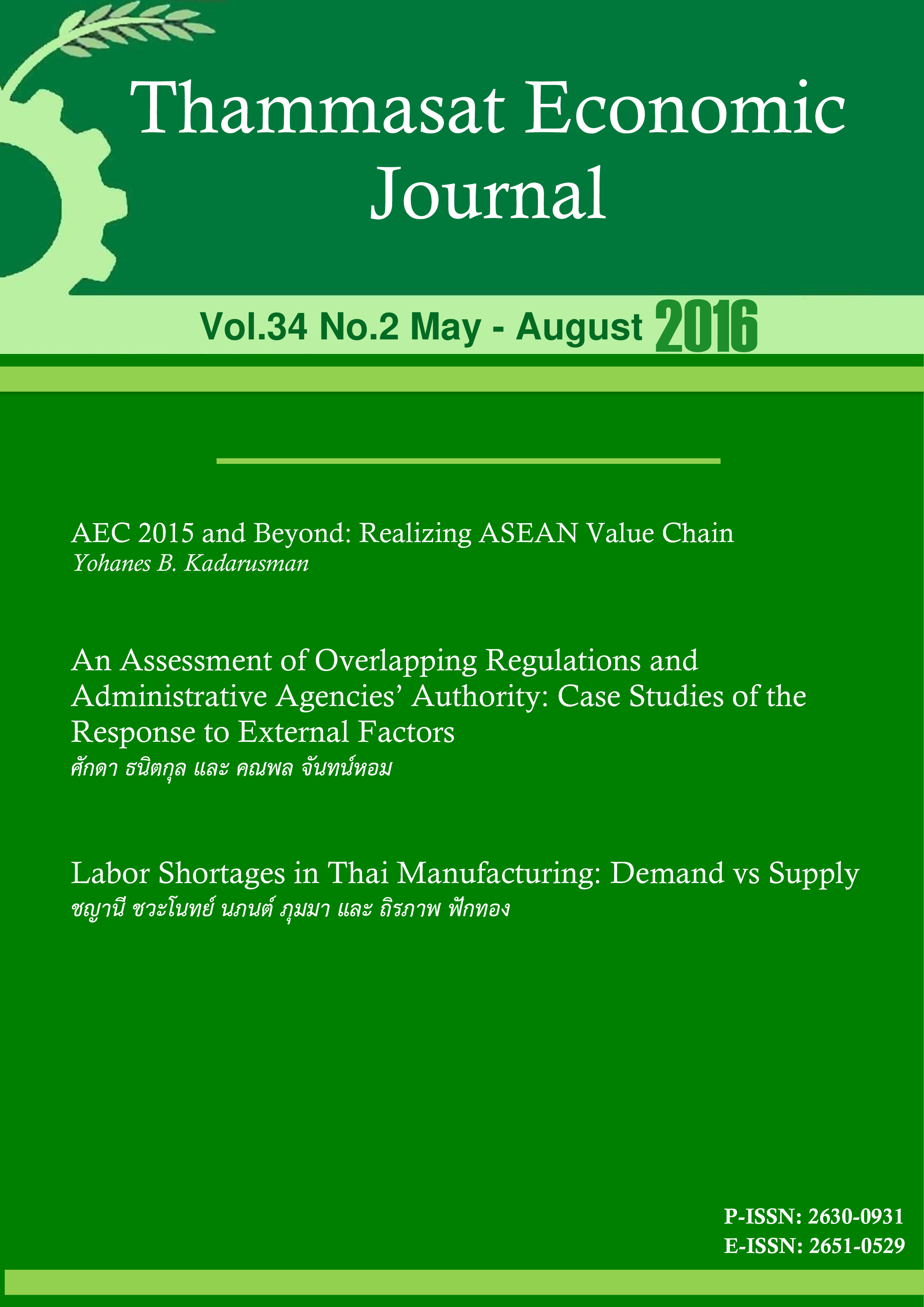AEC 2015 and Beyond: Realizing ASEAN Value Chain
Keywords:
AEC, global value chains, governance, upgradingAbstract
The integration of the ASEAN (Association of South East Asia Nations) into economic community aims to establish a single market and production base, a competitive region, a region with equitable economic development and a region integrated into the global economy. While current analyses mainly highlight on opportunities and threats of the implementation of ASEAN Economic Community (AEC) and its impact upon domestic economy of its member countries, the paper suggests a shift of analysis beyond 2015 toward the competitiveness of the AEC and its members in facing other regions and countries in global economy. Thus the main issue and challenge is how the divergent socio-economy of the AEC members becomes strength rather than weakness in a formation of the ASEAN value chain. The ASEAN value chain recognizes a fragmentation and integration of economic activities at the same time which requires a division of role and labor between the AEC member countries. Individual members of the AEC do not need to undertake the full range of value chains but takes part in particular tasks/activities/functions in which the country has comparative and competitive advantages. By realizing the ASEAN value chain, it will widely open opportunities for its member countries to fully join the economic community, to improve competitiveness through human capital and capability, and to capture increase share of value added created domestically through an upgrading toward high-skill content activities over time.
References
ASEAN: AEC Blueprint. www.asean.org accessed on 5 January 2015
De Backer, K & S. Miroudot. (2012). “Mapping Global Value Chains”,paper presented in Final WIOD Conference: Causes and Consequences of Globalization, Groningen, The Netherlands, April 24-26.
Dicken, P. (1998). Global Shift: Transforming the World Economy, 3rd eds., London: Paul Chapman Publishing Ltd.
Gereffi, G. (1994). “The organization of global buyer-driven commodity chains: How US retailers shape overseas production network”. In G. Gereffi and M. Korzeniewicz (Eds.) Commodity Chains and Global Capitalism. 95-122 London: Greenwood Press.
Gereffi, G., J. Humprey & T. Sturgeon. (2005). “The governance of global value chain”. Review of International Political Economy, 12(1), pp. 78-104.
Gaulier, G., F. Lemoine& Denis Unal-Kesenci. (2005). “China’s integration in East Asia: Production sharing, FDI & High-tech trade”. CEPII Working Paper No. 2005-09.
Humphrey, J. & H. Schmitz. (2002). “How does insertion in global value vhain affect upgrading in industrial clusters?” Regional Studies, 36(9), pp. 1017-1027.
Kadarusman, Y. (2010). “Global Value Chains and Technological Capabilities: Analysing the dynamics of Indonesia’s garments and electronics manufacturers”, PhD dissertation, University of Manchester, Manchester.
Kadarusman, Y. & K. Nadvi. (2013). “Competitiveness and Technological Upgrading in Global Value Chains: Evidence from the Indonesian Electronics and Garments Sectors”. European Planning Studies, 21(7), pp. 1007-1028.
Kaplinsky, R. (2005). Globalisation, Poverty and Inequality: Between a Rock and a Hard Place. Cambridge: Polity Press.
Kaplinsky, R. & M. Morris. (2001). A Handbook for Value Chain Research At https://www.ids.ac.uk/ids/global/pdfs/VchNov01.pdf. accessed 28 January 2016.
Navas-Aleman, L. (2011). “The Impact of Operating in Multiple Value Chains for Upgrading: The Case of the Brazilian Furniture and Footwear Industries”, World Development, 39(8), pp. 1386–1397.
OECD: Statistics on Trade in Value Added and Global Value Chains Indicators https://stats.oecd.org/Index.aspx?DataSetCode=TIVA2015_C1 accessed on 5 January 2016
OECD-WTO: Trade in Value Added: Concepts, Methodologies and Challenges, https://www.oecd.org/sti/ind/49894138.pdf accessed on 6 January 2015.
Ponte, S. and J. Ewert. (2009). “Which Way is “Up” in upgrading? Trajectories of Change in the Value Chain for South African Wine”, World Development,37(10), pp. 1637-1650
Rabellotti R. (2001). “The effect of globalisation on industrial districts in Italy: The case of Brenta”, IDS Working Paper, no. 144, Institute of Development Studies, University of Sussex: Brighton.
Shih, S. (2005). Reforging Acer: Create, Grow and Challenge. Beijing: CITIC Publishing House.
Thee, K-W. & M. Pangestu. (1998). “Technological capabilities and Indonesia’s manufactured exports”. In D. Ernst, T. Ganiatsos& L. Mytelka (Eds.) Technological Capabilities and Export Success in Asia. 211-265. London: Routledge.
Tewari, M. (1999). “Successful Adjustment in Indian Industry: The case of Ludhiana’s woolen knitwear cluster”, World Development, 27(9), pp. 1651-1672.
United Nations Commodity Trade Statistics Database (comtrade.un.org)
World Trade Organization: International Trade Statistics 2014. www.wto.org accessed on 5 January 2015.










